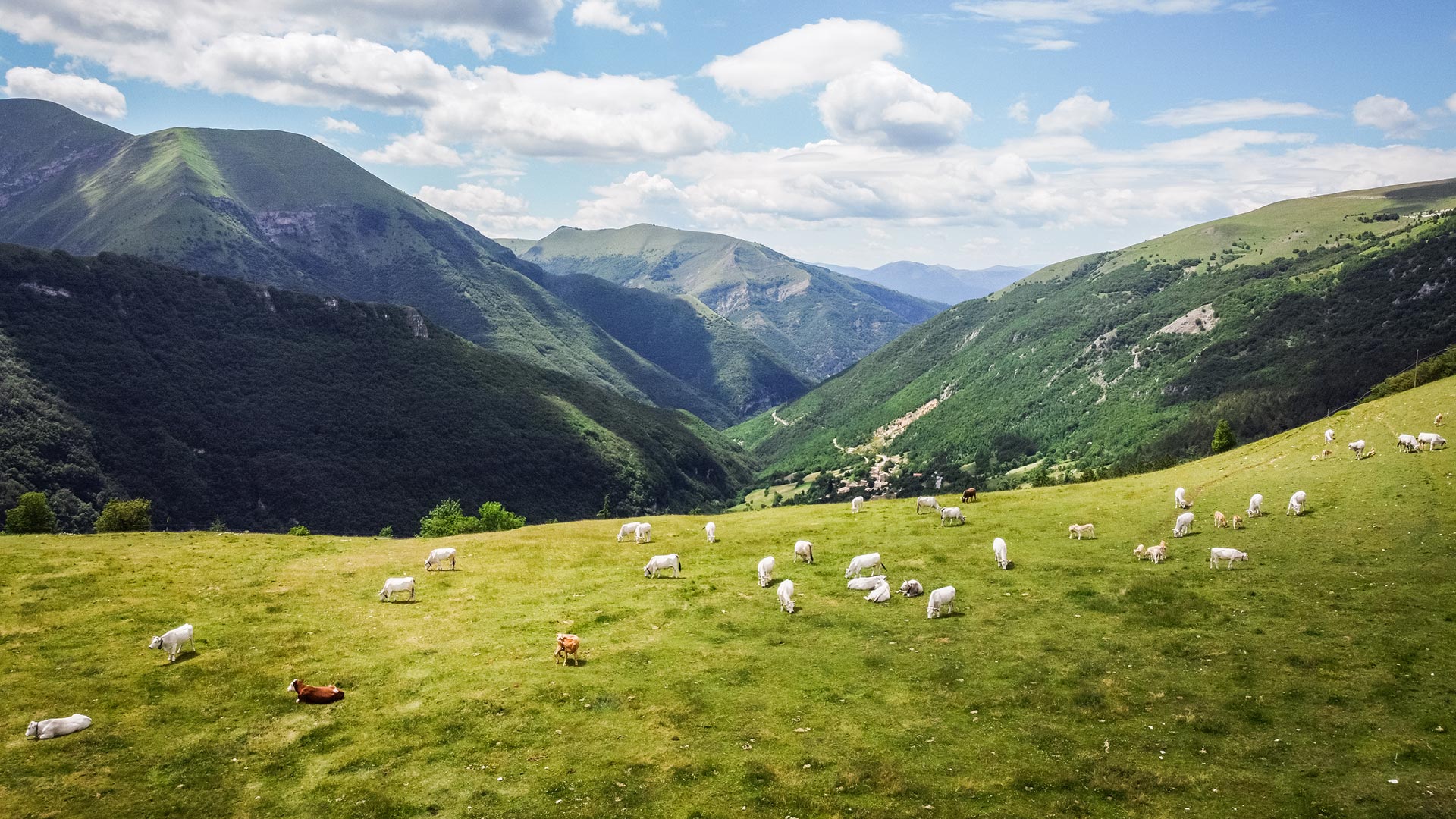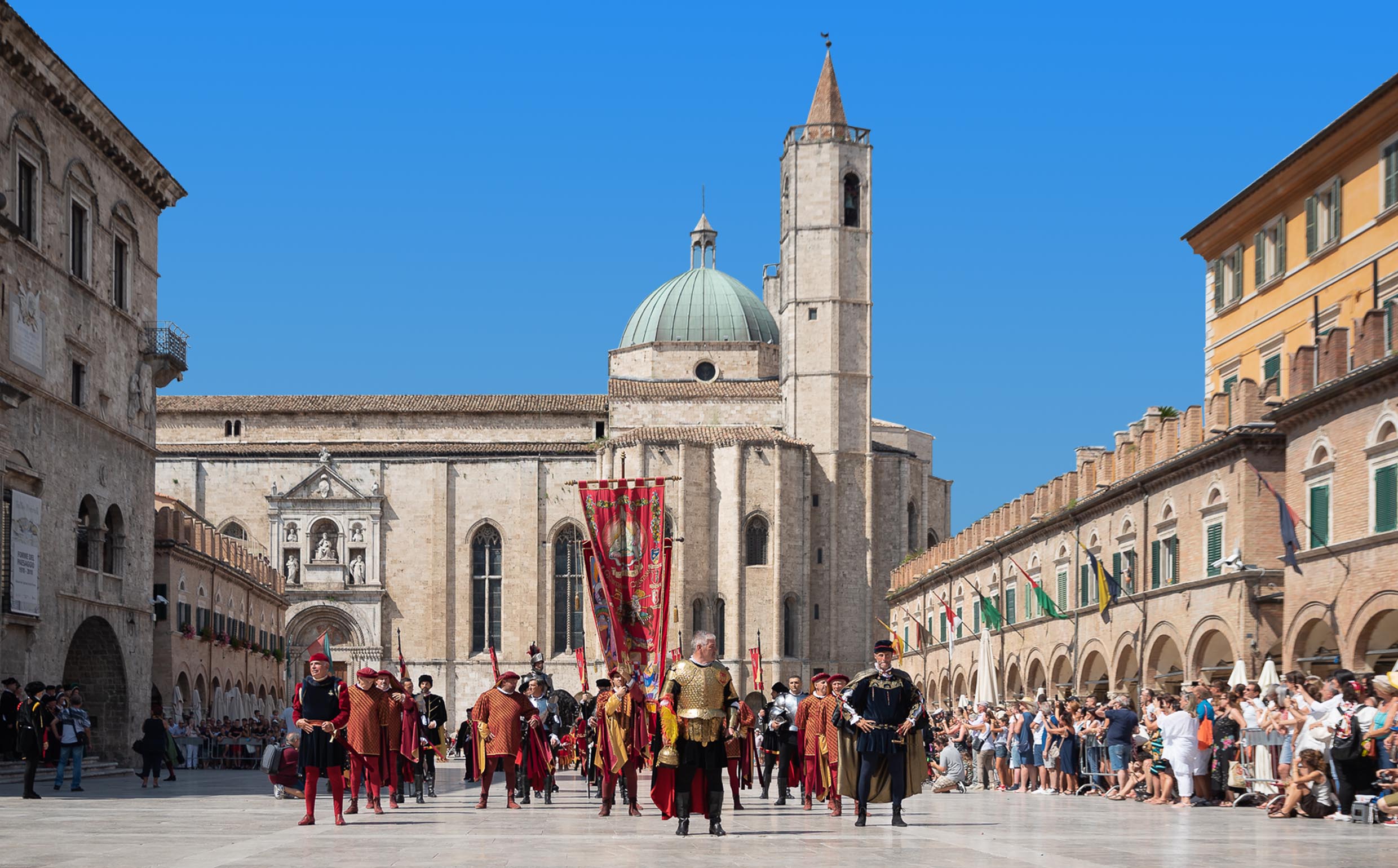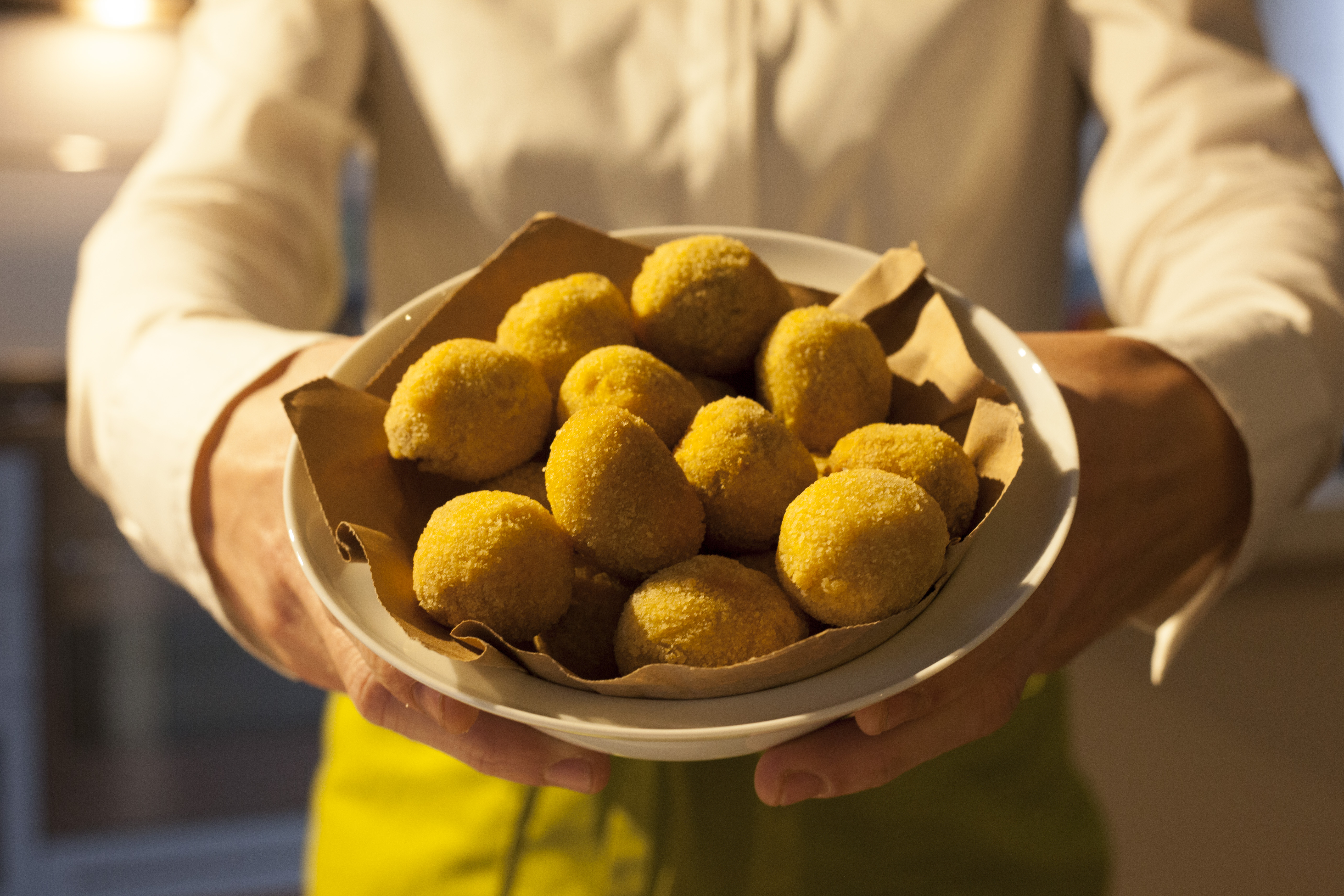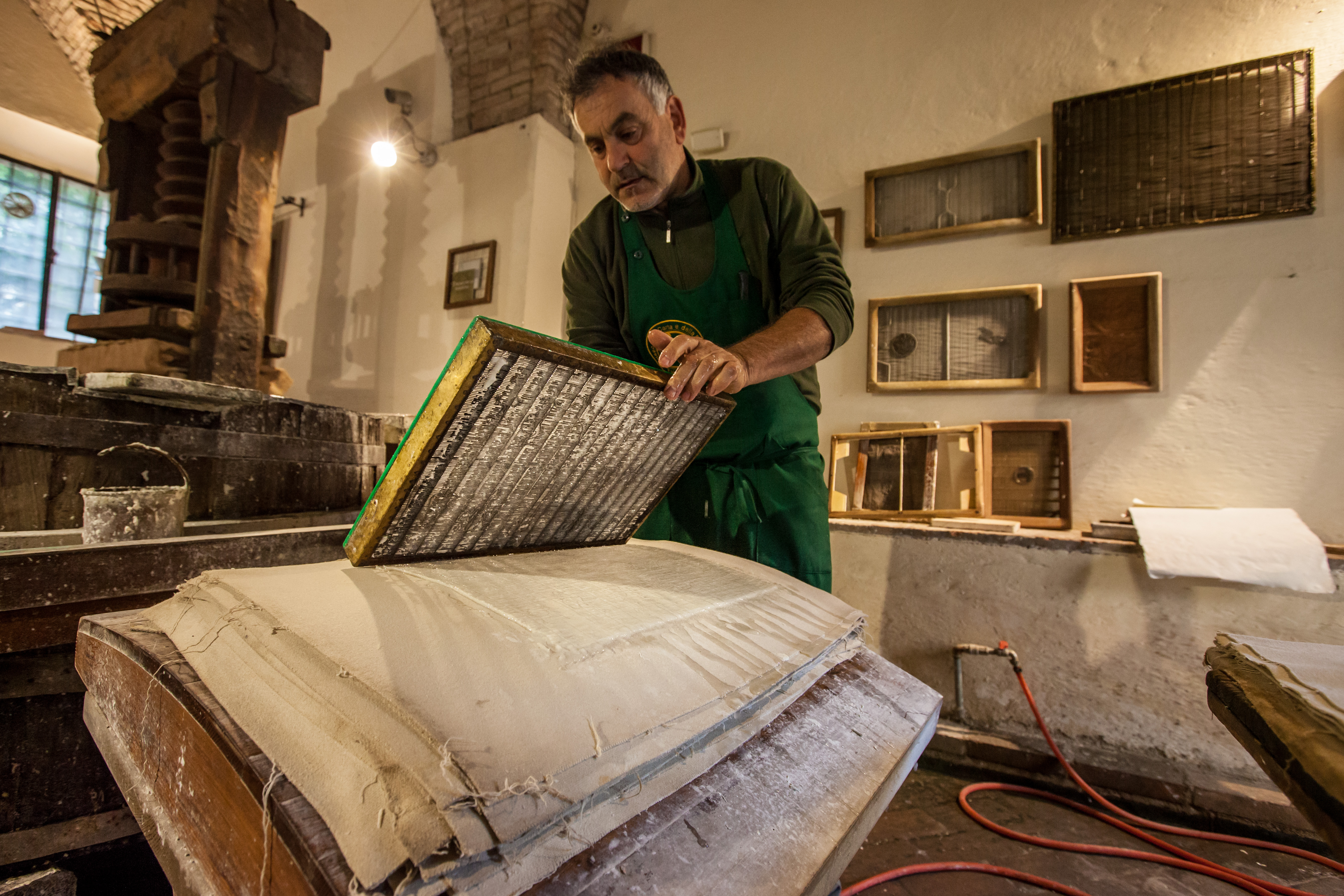Culinary delights - Marche Tourism
Shopping and good food
From the delicious fish of the Adriatic to the tasty dishes of the hills and mountains, the Marche offers an incredible variety of food cooked in the traditional manner. There are a vast number of recipes for fish, often very similar right along the coast: there are, however, various versions of the brodetto (fish soup), including those of San Benedetto del Tronto, made with green peppers, and Porto Recanati, flavored with saffron, and those of Fano. Stoccafisso all’anconetana (Ancona stockfish) is one of the tastiest Italian versions of this type of fish. Freshwater fish is also very popular, especially trout in the areas of Sefro, in the upper Potenza valley, and Ussita, at the foot of the Monti Sibillini. Pork is the staple item in the cuisine of the inland areas. Although most Italians are not aware of this, porchetta (roast suckling pig), a national favorite, originated from this region. As regards cured pork products, there are the renowned Carpegna hams, the salame of Fabriano, ciauscolo (a type of spreadable salame) from Visso and elsewhere in the province of Macerata, and coppa, a sausage containing various parts of the pig that is eaten cooked. There are also numerous sheep’s milk cheeses, the casciotta d’Urbino in the Metauro valley, and pecorino, produced in all the mountain areas. Near the Monti Sibillini, lentils are widely grown; these are eaten with the zamponi (stuffed pig’s trotters) and cotechino (pork sausage) in the Christmas period. The Marche is also well known for the cultivation of truffles, of both the black and white varieties; both types of tuber are found in the inland area of the province of Pesaro and Urbino, while, in the province of Fermo, there are white truffles in Amandola whereas in the province of Ascoli Piceno, Comunanza is noted for the white truffles and Castelsantangelo sul Nera for the black variety. The great specialty of Ascoli Piceno is olive all’ascolana; it consists of olives stuffed with minced meat and then fried. The best-known pasta dish in the Marche is maccheroncini di Campofilone, very thin tagliarini served with meat sauce. The celebrated recipe for vincisgrassi dates from the second half of the 18th century; broad strips of homemade pasta are alternated with layers of minced meat, chicken giblets, and bechamel sauce, and there are two versions, one from Ancona, the other from Macerata. Lastly, there is a wide range of sweets, which are eaten with dessert wines such as vino di visciola, a famous one being made with black cherries (amarene) from Cantiano, or with the Vino cotto di Loro Piceno: funghetti of Offida; cavallucci of Apiro and Cingoli; the salami of figs; calcioni; bostrengo, from the province of Pesaro and Urbino; torrone (almond nougat) and frostengo in Camerino, a Christmas sweet made with raisins and dried figs; and a great variety of doughnuts and tarts filled with home-made jam.
-
For all tastes
There are numerous events in autumn, such as the truffle fairs in Sant’Angelo in Vado, Acqualagna, Pergola, and Amandola. The Casciotta d’Urbino was the favorite cheese of the great Michelangelo; when he lived in Urbania, once known as Castel Durante, he loved to receive as a gift sheep’s milk cheeses from the Metauro valley.
-
Wine festivals and museums
Generally speaking, a long festival during the year or visits to the wineries are focused on each of 15 DOC (Designation of origin) wines of the Marche. The best-known of the region’s wines is the Verdicchio dei Castelli di Jesi, celebrated in October by a grape harvest festival in Cupramontana, where there are the Museo dell’Etichetta and a wine shop. Other events, some of national importance, include Verdicchio in festa in Montecarotto in July, a fair of local wines and, in autumn, the Verdicchio d’Oro competition in Staffolo, where there is a wine shop and museum. The Verdicchio di Matelica is also particularly well known. The leading red wines in the region are Rosso Conero, to which is devoted a festival the first week of September in Camerano. The Rosso Piceno Superiore is celebrated by a wine fair in Offida in September. Other red wines include the Vernaccia di Serrapetrona (festival in August), the Lacrima di Morro d’Alba (festival in May). Well-known white wines also include the Falerio dei Colli Ascolani, the Bianchello del Metauro and the Bianco dei Colli Maceratesi. Other DOC wines: the Esino, Rosso Piceno, Serrapetrona, Terre di Offida, I terreni di San Severino, Pergola and San Ginesio. The Marche also boast 5 DOCG: the Vernaccia di Serrapetrona, Conero Riserva, Verdicchio di Matelica Riserva, Castelli di Jesi Verdicchio Riserva, and Offida. The Grappolo d’Oro festival is held in Potenza Picena in September. To the “wine culture” are dedicated: la Festa della sapa in Rosora, Appassimenti Aperti in Serrapetrona to learn the Vernaccia’s production methods, the Sagra del vino cotto in Loro Piceno and the Festa del vino cotto in Lapedona. The region also boasts the IGT Marche (Typical Geographical Indication), used to indicate the best table wines on the community market, it includes the provinces of Ancona, Macerata, Fermo and was created in 1995.
-
Remembering the past: Museum of the rural culture
In the Marche, there are numerous museums focused on the culture and traditions of the rural population containing farm implements and replicas of the rooms where the families of the tenant farmers spent their lives, including, obviously, the kitchen. The best-known in Senigallia is the Museo di storia della mezzadria “Sergio Anselmi” (history of agriculture). Other interesting museums are in the Abbazia di Fiastra, near the Cistercian abbey, in Amandola, Fabriano, Montefiore dell’Aso, Montelupone, Morro d’Alba, Piandimeleto, Ripatransone, San Lorenzo in Campo and Sassoferrato. In Sant’Angelo in Vado there is a museum dedicated to traditional trades and crafts, the Vecchi Mestieri. Other specialized museums, linked to aspects of the world of work in the Marche in the 19th and 20th centuries, include the Museo della Miniera di Zolfo (sulphur mines) in Perticara and Cabernardi, the permanent exhibition of equipment for making Vino cotto in Loro Piceno, the Museo della Carrozza (carriages) in Macerata and the Museo del Biroccio in Filottrano, holds a specialized collection of gaily painted farm carts of the Marche.









